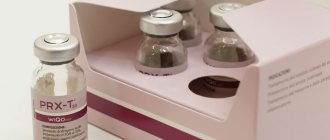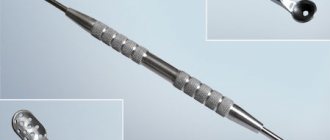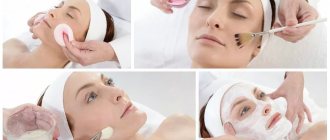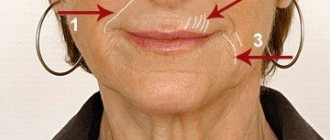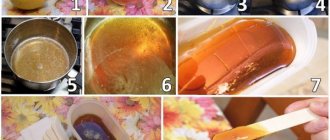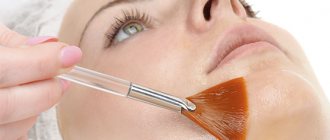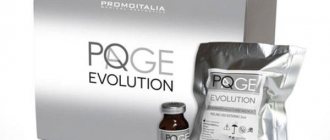Depending on the concentration of the active substance, there are superficial and superficial-medium salicylic peels. Superficial treatments are carried out with salicylic acid of low concentration (10-15%). Suitable for all skin types. They are used to improve problematic and oily skin, treat post-acne, remove sebaceous secretions, cleanse the mouths of the sebaceous glands. With the help of superficial peeling, you can remove comedones and blackheads, normalize the secretion of glands and remove dead epidermal cells.
Superficial-medium salicylic facial peeling is carried out with concentrated acid (25-30%). Acting on the deeper layers of the dermis, it evens out the microrelief and allows you to successfully fight the first wrinkles. Effective in treating hyperpigmentation. With the help of superficial-medium peelings, you can also solve more serious problems, in particular, remove atrophic, normotrophic and hypertrophic scars after acne.
For peeling, single preparations containing only salicylic acid and combined cosmetics containing several active ingredients can be used. Salicylic peeling LikOberon is an example of a combined peeling. In addition to salicylic acid, the drug contains licorice extract, glycerin and macadamia oil.
Effect of salicylic acid
The main component of the compositions for this peeling is salicylic (phenolic) acid. Compared to mechanical effects, it has a more gentle effect on the skin. Dead cells are dissolved rather than polished off, which eliminates the traumatic effect on the face. The active substance has high penetrating ability. It causes peeling at the mouth of the hair follicle, which prevents the formation of comedones.
There are several peeling options: superficial, medium, deep. Almond-salicylic belongs to the first type and provides the mildest effect on the skin.
Kinds
Different topical salicylate-based products differ in composition, consistency and methods of application. The forms of peeling also differ in the depth of cleansing of the integumentary tissues. Salicylic acid pastes and solutions are most often used in cosmetology. Solutions are more universal components, suitable for surface and deep processing.
Main types:
- Superficial cleansing of the epidermis. For this, a solution of salicylic acid with a concentration of 15-20% is usually used. This type of peeling is great for acne, keratinization and hyperpigmentation.
- Cleansing deep layers. A salicylate concentration of 25-30% allows for cleansing of the epidermis and upper layer of the dermis. This type of peeling is great for normalizing skin microflora, cleansing pores and eliminating wrinkles.
Creams and ointments based on the active ingredient can be used as daily care products for acne and increased tissue oiliness.
List of indications
Cosmetologists recommend the method of salicylic-chemical peeling for:
- oily seborrhea;
- post-acne (scars, scars);
- acne (face, neck, back, décolleté);
- hyperpigmentation (melasma, chloasma, senile lentigo);
- hyperkeratosis (thickening of the stratum corneum of the epidermis);
- signs of photoaging and age-related changes (fine wrinkles, decreased elasticity and skin turgor).
The main restrictions for salicylic peeling:
- period of pregnancy and lactation;
- the presence of herpetic rashes;
- violation of the integrity of the skin;
- purulent, inflammatory dermatological lesions;
- individual intolerance to the components of the drug;
- increased sensitivity of the dermis;
- sunburn in the treatment area.
What complications can there be after the procedure?
Common complications:
- a feeling of strong tightness of the skin caused by dehydration;
- redness of the skin in the manipulation area;
- severe peeling of the skin;
- swelling and inflammation of the treated areas;
- excessive burning sensation;
- allergy to the components of the drug used for the procedure;
- exacerbation of herpes.
If it was not possible to avoid the negative consequences of peeling, you must try to get rid of them.
Important ! When the situation becomes very difficult, it is best to contact a specialist who will decide on the spot what to do.
It is worth talking to a specialist if there are complications
Achieved effect
The most pronounced result is achieved if you buy a course of procedures (6-8) with an interval of 7-10 days. In the case of acne and oily seborrhea, the inflammatory process is relieved, sebum secretion is normalized, skin shine is eliminated and the amount of rash is reduced. With post-acne, the relief is noticeably evened out, stagnant spots disappear. The action of acid allows you to get rid of hyperpigmentation of different colors and intensity. In patients with hyperkeratosis, it is possible to remove horny layers and achieve a uniform, elastic, velvety and smooth structure of the epidermis.
In addition, you can order salicylic peeling to:
- ensure the prevention of new rashes;
- deeply clean and disinfect contaminated pores;
- even out the complexion, make it natural and healthy;
- smooth out fine wrinkles and reduce the severity of deep ones;
- restore skin elasticity and turgor;
- remove blackheads (comedones).
Contact a medical office in St. Petersburg, where experienced cosmetologists work. They provide high-quality peeling with gentle post-peeling care - for accelerated skin restoration and prolonged results. You can sign up for the procedure at an affordable price.
general information
Peeling is the process of removing the top (keratinized) layer of skin.
This popular cosmetic procedure is necessary to exfoliate dead skin cells, eliminate skin rashes and stimulate epidermal renewal. Types of peeling vary depending on the method of exfoliation of the skin and the depth of tissue cleansing. Most often, superficial removal of keratinized cells is sufficient to improve the appearance of the outer skin. Deep peeling is used for dermatological diseases. Peeling can also be carried out for subsequent treatment of the deeper layers of the skin. Cleansing the epidermis is carried out for clogged pores, acne, hyperpigmentation and other conditions. A cosmetologist can assess the condition of a woman’s skin and choose the safest exfoliation method.
Chemical peeling is the most common method of cleansing the epidermis. Typically, cosmetologists use diluted acids to destroy dead skin cells. Chemicals disrupt the connections between the cells of the surface layer of the skin and release the lower layers of the epithelium. Peeling with salicylic acid helps cleanse pores, increase collagen production, improve skin elasticity and support cellular regeneration.
Best Recipes
Most often, salicylic peeling can be prepared from everything that is in any refrigerator or medicine cabinet. The main thing is to follow the recommended proportions so as not to damage the skin.
With aspirin and lemon
This recipe includes a high concentration of aspirin. You will need as many as four tablets of the drug:
- Grind 4 aspirin tablets into powder, add two egg yolks to them.
- Beat the ingredients until foamy and add 1 teaspoon of lemon juice.
- Apply the finished mixture to your face using a silicone brush, avoiding the area around the eyes, lips and mucous membranes.
- Leave the product on the skin for 8-9 minutes. During this time, prepare a solution to remove peeling: dissolve 10 g of baking soda powder in half a glass of warm boiled water.
- Remove the salicylic film from the face with a cleanser (using a cotton pad), and then wash with cool water.
With aloe
This soft peeling can be used on both problematic skin and normal skin with the first signs of age-related changes:
- The pulp of two medium aloe leaves needs to be mashed in a clean bowl.
- Add acetylsalicylic acid tablet crushed into powder and 1 teaspoon of coffee grounds to the aloe.
- Apply the mixture to your face using a brush or cotton pad, avoiding lumps on the skin (knead the mixture with your fingers).
- After five minutes, rinse off the peeling with a decoction of herbs (you can take chamomile, calendula, sage or other options at your discretion).
We recommend: What are foot peeling socks, what are they and how to use them?
Honey
Another soft peeling option suitable for almost any skin type:
- Grind three aspirin tablets to a powder.
- Add 0.5 teaspoons of purified water and 2 g of honey to the acid. Mix everything well to obtain a homogeneous mass.
- Apply the finished mixture to previously cleansed facial skin and leave for 10–15 minutes.
- After this, rinse off the mask with warm running water and wash again with cool water (this will help close the pores).
- Be sure to apply a moisturizer (preferably night cream or thicker) at the end.
Cost of the procedure
We will indicate the cost of such a procedure in different cities of Russia.
| City | Cost of one procedure |
| Moscow | 2500 rub. |
| Saint Petersburg | 2380 rub. |
| Vladimir | 1980 r. |
| Lipetsk | 1900 rub. |
| Vladivostok | 2100 rub. |
| Yaroslavl | 1840 rub. |
| Arkhangelsk | 1560 rub. |
| Chelyabinsk | 1730 rub. |
Summary
Homemade salicylic peeling is a real alternative to salon procedures. You can choose the composition of the product that is suitable for all parameters, and carry out the procedure at any convenient time. It’s very convenient, pleasant and, most importantly, effective.
But remember! The struggle for beauty and youth requires regularity and an integrated approach. Therefore, choosing salicylic peeling alone for these purposes is at least not reasonable. After all, it is carried out in courses and they can be repeated no more than four times a year, that is, once a season.
The rest of the time, your skin needs careful care and attention to look as perfect as possible.
And remember the motto: “I see the goal, believe in myself and do not notice obstacles!”
Precautions and possible complications
The most common side effects that occur after one or more salicylic exfoliation treatments are:
- redness of the skin;
- excessive peeling;
- allergic reaction (rash, itching, irritation);
- increased skin sensitivity.
We recommend: All about fruit peeling for the face. Recipes and home use
These side effects occur in the following situations:
- ignoring existing contraindications to such procedures;
- too high concentration of salicylic acid in the product;
- incorrect implementation of the procedure: the recommended break between procedures was not waited, the correct proportions of the components were not observed when preparing the drug, the peeling composition was incorrectly removed from the face, etc.;
- ignoring subsequent skin care.
Important. Before using any medications containing salicylic acid, you should first test the product to determine if you are hypersensitive to it.
To do this, apply a few drops of the composition to the inside of the elbow (or to the skin behind the ear) and leave for 15 minutes. If after the specified period no irritation, redness, rash or other abnormality appears in these places, then a full procedure can be carried out.
Stages of carrying out in the salon
Salicylic peeling is a simple and completely safe procedure, but it is better to do it in a beauty salon. Salon exfoliation is performed with more concentrated formulations, therefore it is much more effective than home exfoliation.
Protocol:
- The skin is cleansed with a special preparation that equalizes the acid-base balance of tissues.
- Degreasing is carried out with a pre-peeling preparation.
- Apply several layers of exfoliant. Treatment begins from the forehead, gradually moving down to the chin and neck. Already during the first covering of the skin, burning and tingling may occur. The correctness of the procedure is monitored by the formation of plaque.
- After the last layer has dried, the drug is washed off without using a neutralizer and a soothing and healing mask is applied to the face.
The number of layers applied is determined individually and depends on the thickness of the epidermis and the expected effect. For the face, a liquid exfoliant solution is used; salicylic paste is applied to the rougher skin of the feet, elbows and legs. Exfoliation takes 35–40 minutes.
Answers on questions
Which is better: salicylic or glycolic peeling?
It all depends on what problem you want to solve. If you need to improve the condition of oily skin, cleanse pores and eliminate inflammation, it is recommended to choose salicylic peeling.
Glycolic exfoliation gives the effect of a tightened and radiant face. The procedure evens out tone, increases tissue elasticity and moisture, and restores youth and beauty. More suitable for dry, thin and aging dermis.
The recovery period after peelings also proceeds differently. The glycol version goes on with virtually no peeling. The procedure allows you to lead a normal lifestyle without dropping out of society during the entire course.
As you can see, each peeling is good in its own way and solves specific problems. Therefore, only a cosmetologist can determine which option is best for your skin.
How often can the procedure be performed and how many sessions will be required per course?
For the face, neck and décolleté area, in general, 8–10 procedures are performed every 10–11 days. On hands, exfoliation is performed much less frequently—once a month. The course consists of 4–5 sessions.
If you need to get rid of pimples and seborrhea, use 15 and 25% formulations once a week. To eliminate pigmentation, peeling is performed with a 25 percent solution every 12–14 days.
Should I expect skin peeling after peeling?
Yes, sure. Salicylic acid has a powerful keratolytic effect, so peeling after peeling is always abundant. This is considered a normal reaction to an irritant and is an indicator of high-quality exfoliation.
Peeling begins on days 2–3 and continues for 4–5 days, sometimes more than a week.
What complications occur after peeling with salicylic acid?
If the rules of post-peeling care are not followed or contraindications are neglected after exfoliation, complications may arise.
Most often, women complain about the following unpleasant moments:
- increased sensitivity of the skin;
- irritation, redness of the epidermis;
- swelling of tissues;
- feeling of dryness and tightness, itching;
- local hyperpigmentation.
With proper post-peeling care, all side effects disappear after 2-3 days. If acute, alarming reactions occur, do not wait three days, but immediately seek qualified help. Relieve allergy symptoms with an antihistamine tablet.
How to care for your skin during the post-peeling period
The final result of the procedure largely depends on the correctness of post-peeling care. Therefore, do not be lazy and strictly follow all the recommendations of the cosmetologist. This will help avoid complications and get beautiful and clean skin.
During the rehabilitation period it is recommended:
- refuse steam room, sauna and solarium;
- hold off on visiting the pool and gym;
- Before going outside, protect the treated areas with sunscreen with SPF of at least 40.
In addition to the measures discussed, it is necessary to cleanse the face daily with acidified water and baby soap and apply moisturizing and regenerating products.
To restore skin affected by acne, creams with bisabolol and aloe are suitable. On an oily, porous face, it is recommended to apply preparations with triclosan, herbal extracts and vitamins.
It is impossible to artificially accelerate peeling and tear off crusts. The result of such “care” will be an uneven complexion and the appearance of red spots, which will require deeper exfoliations.
Recommendations from cosmetologists
You can make a peeling based on salicylic acid either with purchased products or with self-prepared formulations. The main difference is that in the second case, you choose for yourself the components necessary for your skin.
But cosmetologists strongly recommend that the first procedure be carried out only after consultation with a specialist. In this way, you can avoid many undesirable consequences, select the optimal recipe, and select the desired concentration of the active substance, which will be justified and effective in your case.
And one more recommendation from professionals. They advise peeling with salicylic acid at home in a special way. It is better to neutralize the composition with a soda solution before washing off.
To prepare it, you need to take a glass of slightly warm water and dissolve a teaspoon of regular table soda in it. Use a cotton pad to treat the surface and only then thoroughly rinse off the remaining composition with cool water. At the end, be sure to apply cream according to your skin type.
My great acid experience, part 1: Salon salicylic peeling (description, process, photo)
In the comments to yesterday's post about the SVR Lysalpha Cicapeel Gel peeling, there were many requests to tell about other acid products that I used (and I tried a lot of them). The post is almost ready for publication, but I thought it would be nice to tell my “acid” story from the very beginning, namely, the salon peeling course that I took from June to November 2013. As you understand, a lot of time has already passed, so I’m ready to put not the most unpleasant photos on wide display. At that time, I kept a diary in which I carefully wrote down all my feelings, which, in fact, I want to share. With this series of posts I am not asking for advice.
, recommendations or evaluation of the chosen treatment tactics.
The main goal is to share my experience
, tell and show how certain peels worked on my skin, and also, perhaps, help someone decide on these procedures or, conversely, refuse them.
Background
I have lived most of my life with a disease called acne. The first pimples and pimples began to appear at the age of 12, after I had chickenpox. Since then, I haven’t had a single day with perfectly clear (acne-free) skin. In an attempt to solve this problem, a lot of tests were taken, a lot of doctors were visited, a lot of drugs were taken, and it’s hard to even imagine how much was smeared on the face. There were periods when I was tired of all this and did nothing at all, since I didn’t see any tangible results. The last approach was started in 2011, when I again believed that something could be changed. I already wrote about the details earlier in the article Single Care
, so I won’t repeat myself. I’ll just say briefly that the most effective were the refusal to use towels (completely switched to disposable paper ones) and complete skin care, including cleansing, toning and moisturizing. In addition, the use of lotion (Ugresol) based on benzoyl peroxide, one of the most effective drugs for the treatment of acne, was of great benefit.
And everything would be fine if not for two big “buts”: the acne never completely went away (rashes and a couple of deep inflammations still occur), and the 14-year war did not pass without a trace, leaving behind quite colorful traces in the form of scars, spots and scars that are simply impossible to remove with skincare products (I once tried bodyagi, but I would sincerely not recommend doing this, the consequences could be disastrous). I knew for a long time and was ready for the fact that all this would be removed in rather aggressive ways, and at the doctor’s office, and not at home. True, the treatment itself was constantly put off until later, because there were many other pressing matters and problems.
And now this moment has come, especially since the stars aligned so well that I had the opportunity to undergo the treatment that I had been planning for a long time.
Salicylic peeling: description, process, “immediately after” photo.
When I met with the cosmetologist, I was offered a treatment plan for my problem. To finally get rid of acne and scars, I will have several chemical peels done. First - salicylic acid (to normalize the functioning of the sebaceous glands and remove all inflammatory processes), and then TCA (trichloroacetic acid).
The procedure is as follows. A thin layer of solution is applied to cleansed and dry skin, which immediately begins to burn the skin. I can’t say that the procedure was too painful; everything was quite tolerable. The oven stops immediately after drying out. When the first layer dries, apply the second, third, and, if necessary, the fourth in certain areas. I just applied 4 layers (on the most problematic areas). After everything had completely dried, a restorative cream was applied to the skin, which also burned a little.
The skin felt tighter and more elastic, the pores became smaller, the skin tightened, and all the pimples that were hiding somewhere inside began to appear outward. At the same time, the complexion, despite the redness, became more even.
You cannot wash your face after this procedure for 24 hours (if you noticed, the solution is not washed off with anything, but is sort of sealed with cream).
Well, now a photo a few hours after the procedure.
Most often, when making swatches of cosmetics on the face (and if you have been reading me for a long time and constantly, you may have noticed that I do this extremely rarely, when the skin is in more or less normal condition), I choose the most aesthetic angles. Today there will be photos of everything that I usually don’t show. And this, in fact, is what we will fight with.
Despite the redness, you can see post-acne spots and scars with scars. The most affected (from acne, not from peeling) are the temples, cheeks, and even the skin under the eyebrows.
On the forehead, in addition to acne scars, there are also scars from chickenpox, plus the beginnings of wrinkles. By the way, on the skin of the forehead you can most clearly see how the skin has tightened (the photo was taken without a flash, this is how daylight is reflected). In addition, one of the two horizontal wrinkles completely disappeared, while the second was significantly reduced.
The areas with the most active rashes for me now are the areas around the mouth and chin:
As well as the lower jaws and neck near the ears on both sides.
Please note that what looks like peeling in the photo is either rolled off cream, or the remnants of a paper napkin, which I once blotted my face with to absorb excess cream.
Immediately after the procedure, you can go home, and you don’t have to worry about the sun. It was strictly forbidden to wash your face in the evening, as well as to use any cosmetics other than those prescribed by the cosmetologist (Pharmskincare brand). In addition, it was said that you should not press anything, rip off peelings if any, use towels (but I haven’t done this for a long time), and touch your face with your hands. It is also advisable to exclude decorative products, but if walking with a bare face is completely uncomfortable, you can use loose, non-comedogenic powder.
Diary
Last time I wrote on the day of the procedure. As required, I didn’t wash my face at all that evening, and the next morning I started using Pharmaskincare products for home care. So on the second
After a day of redness, the redness gradually began to subside, and the skin began to dry out and tighten. In the most sensitive places (nasolabial folds, chin) a thin crust of dried skin has formed. Perhaps for the first time in my life I felt what it was like to have dry skin. At the same time, nothing itched; the previously emerging pimples matured and began to dry out.
On the third
day, in places with active facial expressions (the same nasolabial lips and the skin around the mouth), small cracks began to appear on the crust, and the skin began to peel off little by little. By the evening of the same thing everything looked like this:
And these are the biggest peelings I've ever had. On the remaining parts of the face, the skin renewed more smoothly, and the peeling was not clearly expressed (according to the results of numerous surveys of others, only I saw these same peelings). During the fourth
and
the fifth
day, the skin continued to peel off, which was especially noticeable when wiping the face with tonic, since small pellets of peeling skin remained on the cotton pad.
By the end of the first week, the peeling had practically stopped. Along with them, some of the post-acne went away, the pores narrowed, and the skin began to have a more uniform tone.
Then I was a little sprinkled in the area of the lower jaw and above the upper lip, but after a couple of days it became clear why it happened (hello to cyclical nature). Thanks to the drying effect of the cream, they went away quite quickly. However, by the end of the second week, several pimples began to form again in the same areas.
So, on the 14th day
were the following results:
You can see how the pores have narrowed, the skin has become fresher, cleaner and more nourished.
There are no new rashes on the forehead, nose and upper cheeks, the relief is more even.
New pimples are brewing above the lip.
And on the lower jaw, old ones are activated (I call them “sleeping volcanoes”, since they can remain in a “dormant” state for a long time, manifesting themselves only in the form of a compaction under the skin, and then they become inflamed and break out).
These photos were taken literally before leaving the house for the second peeling procedure
. The cosmetologist positively assessed the results of the first procedure, saying that everything was going very well.
The second time the solution was applied in 3 layers, the pain (if you can call it that way, some baking and warming of the skin) was no stronger than the first time. The skin, of course, turned red, but it was quite tolerable in order to walk down the street without scaring others with your appearance.
Arriving home, as expected, I ran to film everything.
You can notice that the pimples above the lip have become more formed, and only a few hours have passed (by the evening they were almost completely gone).
Everything on the forehead is generally beautiful (it seems to me that there wasn’t even any redness there).
The pores on my cheeks tightened and the pimples dried out before my eyes.
Just like the first time, I didn’t wash my face at night.
Notes in the margins
What is the percentage of salicylic acid in the peel that I had?
Since our main goal is to treat acne, 70% salicylic acid was used.
Probably the most difficult moment
For me it was giving up decorative cosmetics. I think those who have encountered the problem of acne will completely understand me. The most terrible psychological discomfort and self-doubt in the absence of makeup armor is not so easy to overcome. It seems that everyone around them sees how bad everything is, they turn away, grimace, or they are simply disgusted (in fact, everything is not at all like that, but the imagination is actively drawing out everything to strengthen this fear).
On the other hand, any makeup in this situation can only do harm, and applying foundation or powder on top of flaky skin... in general, it’s not clear whether it will be better. Thus, I stubbornly tried to do without makeup (well, except in very rare cases I used powder), and during the second week I realized that somehow I didn’t really want to. After all, if you look at the condition of the skin, then everything is not so scary, so as not to go out “nude” in public (I have seen more than one person with a much worse stage).
A month later
Today marks exactly one month since I started treating my skin for acne using acid peels. Today there will be a continuation of the story + interim results after a month of active treatment and care.
I’ll start where I left off last time, namely, from the second day of repeated peeling
.
In my case, after salicylic peeling (after other peelings there may be a different reaction), it was the crust that formed in the area of the nasolabial folds, since the skin is thinnest there. I can’t say that it looks particularly scary, and this skin condition lasts only one day, and if you correctly time your trip to the cosmetologist (for example, on Friday evening), then by the beginning of the work week the skin will look quite decent .
Within 6 days, the peeling completely disappeared and the skin was renewed. In some places (above the lip and along the lower jaw line), acne has become more active, which is quite logical, since salicylic acid “spurs” them to come out. At the same time, the forehead and cheeks were almost completely cleared of rashes.
In some places, post-acne spots remained, and in some places new pimples began to appear.
A particularly unpleasant “comrade” popped up above my lip, and since squeezing such “joys” is strictly not recommended, I had to go with it to a cosmetologist to have it removed, and at the same time undergo several pleasant procedures.
First of all, it was necessary to get rid of a huge pimple above the lip, which was done using special tools so as not to injure the skin and tissue.
After which an antibacterial mask was applied to the skin, and then serum. In areas of rashes, we additionally went over with a salicylic acid solution to “cauterize” the emerging activity. The mask is professional, so it can only be made in a salon. At first it feels like an ordinary clay mask, but during the drying process it does not tighten the skin, and some activity is felt (slight tingling and tingling).
The interesting thing is that after such a procedure I had a purely subjective feeling that all bacteria and inflammation had completely disappeared from the skin. It’s difficult for me to explain this in words, and it’s not visible visually from the photo, but from the feelings... Do you know how much a developing pimple hurts? Or an eel? Now imagine that it is visible on the skin, but there is no pain or inflammation at all, that is, completely.
After the mask and local peeling, the skin problem areas looked like this:
Over the next few days, as usual, the treated areas of skin peeled off. On the forehead, cheeks and above the lip (yoo-hoo, progress!) nothing new has appeared, but along the jaw line the activity continues (in this area I have a lot of deep subcutaneous inflammations that need to get out, so they come up) .
It’s interesting that my acne somehow goes from top to bottom: first the forehead cleared up, then the cheeks, the area above the lip, and even the neck (with the exception of one or two pimples). All that remains is to overcome the very bottom (chin and jaw).
And next time I’ll tell you about how and with what they did this to me (for those who are very curious, a small spoiler – we’ll talk about Jessner’s peeling).
Increase
Ready-made products for use at home
For those who prefer proven professional cosmetic products, a list of ready-made preparations for home peeling is provided. All of them contain salicylic acid:
- Natura Bisse Glyco 3 Peel. It is an ampoule preparation with salicylic and glycolic acids. The set also includes carbon powder (12 bags of powder and 12 ampoules of acids). The cost is 20–21 thousand rubles per course set.
- BeautyMed. The composition includes six exfoliating compounds: almond, milk, lemon, grape, glycolic, salicylic. One bottle contains 50 ml of the finished drug. Cost – 4–4.5 thousand rubles.
- Stopproblem. Combines salicylic acid and enzymes. One package contains 100 ml of the drug. Cost – 200–300 rubles.
- Propeller. Peeling with natural salicylates and lactulose. Package volume – 100 ml. Cost – 150–200 rubles.
Photos before and after
Photos before and after a course of salicylic peeling procedures No. 1
Photos before and after a course of salicylic peeling procedures No. 2
Photos before and after a course of salicylic peeling procedures No. 3
How to exfoliate at home
Chemical peeling with salicylic acid has its own protocol. Some steps may vary. We will present the standard algorithm and indicate some nuances.
- Cleansing. Remove makeup, wash with foam or cleansing gel. Next, there are two options - steam your face over a water bath or make a warm compress, or apply a nourishing softening mask made of white clay, with honey and kefir, from avocado. Steaming will be more effective to achieve maximum effect. But for those with thin, sensitive epidermis, it is better to use a mask.
- Antiseptic treatment. Chlorhexedine or other pharmaceutical preparations without alcohol are used. During this procedure, the skin becomes very sensitive to various pathogenic microflora and this stage will help to avoid infection.
- Application of the composition. The prepared drug is applied using a cosmetic brush or cotton pad. The product is distributed in a thin, even layer over the entire surface and left to act for a certain amount of time. It depends on the skin type, the presence of problem areas, and the recipe.
- Removing the mask. A neutralizing soda composition is used, followed by washing with cool water. Pat the skin with a terry towel and let dry. Treat with antiseptic again.
- Apply a soothing moisturizer, preferably evening.
Peeling with salicylic acid should be done in a course that consists of 5-6 procedures at intervals of a week or 10 days.
